
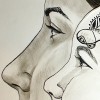
Jennifer Mcleod
4th Year, Art Education Specialization
The inner child
ink and collage on paper
11” x 14”
2012
Inspired by the idea of the child within, and the notion that learning is a continuous process throughout our entire lives, this ink drawing suggests that as artists and teachers, we each need to tap into the creative energy, wonder and play of our own individual inner child. By doing so we continue to learn as artists, teachers, and individuals, and also discover new ways of knowing that sustain us.
**original image currently not available**
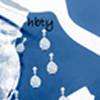
Daryl Zoellner
3rd Year, Art Education Major
HBTY (Happy birthday to you)
digital print
7” x 10”
2010
For me, children’s art tends to be driven by high emotions. Inspired by visions of battle scenes, princesses, dragons, and superheroes, children’s drawings are filled with fantastical imagery and emotional expression. As adults, our creative expression changes in relation to our life experiences. This digital work is inspired by the emotional event of my daughter’s thirtieth birthday. Accessible, transformative, and sharable, digital photography provides us with the possibility to re-imagine emotionally charged memories as artistic creations.
**original image currently unavailable**
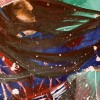
Megan Kanerahtenha:wi Whyte
3rd Year, Art Education Specialization
Spirit dancers
acrylic on canvas
30” x 30”
2011
Created for the Echoes of a Proud Nation Pow Wow in 2011, the concept for Spirit dancers was inspired by the visual, physical and spiritual languages of the Mohawk culture of Kahnawake. Dance is a major component of the Pow Wow ceremonies, which inspired the brushstrokes and composition in the artwork. Each canvas embodies the movement of energy and rhythm, while exploring color combinations and paint application. Language in this artwork is composed of intertwining voices, definitions, and ideas related to life and creation. The combination of dance, color and culture as a hybrid language, provides the opportunity for learners to explore their own languages in both a mixed media and mixed conceptual format.
**original image currently not available**
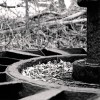
Lauren Costello
2nd Year, Art Education Major
Mills: Sault-au-Récollet
darkroom photography
12” x 9”
2011
These three works belong to a series of photographs that document the ruins of Montreal’s historic Des Moulins watermills. Built in the early eighteenth century in the Ahuntsic borough, the watermills lie on the boundary between the parish of Sault-au-Récollet and the Ile-de-la-visitation. Originally, the parish of Sault-au-Récollet was developed to surround the watermills.
This site helps to inform us, as citizens of Montreal, of our historical and sociological past. The series aims to engage viewers to critically think about their environment, and consider what contribution we might make to the site’s historical preservation.
**original image currently not available**
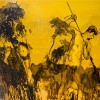
David Goranitis
2 ème Majeur en Education artistique
La Naissance de Sparte, l’Odyssée et Cronos
verre soufflé, gravure sur verre, transferts d’images au jet de sable, cuissons de lustres métalliques, cuisson d’émail
21” x 10” x 10”
2011
La Naissance de Sparte
Pièce ambrée. Illustre le mythe de Cadmos ou la naissance de Sparte. « Cadmos fait ce qui lui est prescrit, il ramène l’eau et sème les dents du Dragon. À peine a-t-il semé ces dents qu’aussitôt de chacune d’elles surgit un guerrier, déjà adulte, tout en arme, ce son les Spartoi, les Spartes, c’est-à-dire les semé… » (Jean-Pierre Vernant. L’Univers, Les Dieux, Les Hommes. Éd. Du Seuil, 1999.)
l’Odyssée
Pièce blanche. Nul besoin de présenter l’Odyssé d’Ulysse ou l’histoire du héros rusé qui est parti de la guerre de Troie et sera confronté aux aléas des dieux et divinités de toutes sortes, dont le cyclope et les sirènes.
Cronos
Pièce bleue. Voici le mythe qui illustre la naissance du monde. «Cronos s’accouple à Rhéa et aura des enfants, qui vont donner naissance à d’autres enfants, mais dès qu’il a un enfant, il l’avale, il le dévore, il le met dans son ventre. Tous les enfants de Cronos et de Rhéa sont ainsi engloutis dans la bedaine paternelle…» (Jean-Pierre Vernant. L’Univers, Les Dieux, Les Hommes. Éd. Du Seuil, 1999.)
**original images currently not available**
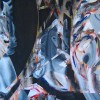
Caroline Steele
3rd Year, Art Education Specialization
Points de vue
acrylic on raw canvas
72” x 96”
2011
The possibility of various approaches and perspectives to art making has inspired this piece. As an artist and educator, I have learned that regardless of the specificity of a subject, each individual adopts a unique approach to creating an image. Each approach relates to personal experience, understanding and expression. This painting is a reflective piece that aims to merge three of my own studies for creating an image in three different styles into one visual language. This exploration of style, approach and voice, suggests that we do in fact speak one hundred languages.
**original image currently not available**
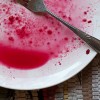
Adrian Bracisiewicz
2nd year in Art Education Major
Traces: Food
digital photography
16” x 20”
2011
These three digital works are part of a series of photographs that document traces of human existence. The subject of consumed food provides an example of how individuals leave traces in the spaces they inhabit. Aesthetically, food leaves behind a painterly residue while conceptually revealing the traces of human consumption. For instance, the traces from a simple plate of linguini with tomato sauce, creates interesting composition of lines, swirls and colour. Documenting food remains on plates will eventually contribute to a larger project I intend to develop which deals with the variety of traces that we leave behind in our daily life.
**Original images currently not available**
Philippe Mastrocola
3rd Year, Art Education Major
Remembered
spray paint, DSLAR time lapse film 40 sec.
2011
This time-lapse memorial piece is dedicated to the life and visual work of my late friend. As an artist, he shared his love for art and inspired the lives of many people. It is through his artwork and his legacy that I am inspired and reminded to take full advantage of the life I am living.
Julie Gagnon
BFA (Spécialisation, Education artistique)
Avis: Prof en art nouvellement diplômé cherche emplois
2011
Comme tous, l’été fut à la fois une délivrance et une torture. J’avais obtenu mon diplôme et mon brevet, mais je n’avais aucun emploi certain pour septembre.
Ma récente graduation en enseignement des arts a fait de moi une nouvelle enseignante en arts visuels. (Jeune «art educator» ne despérez-pas, c’est possible!) Par le fait même, ma vie, mais surtout ma vision, a grandement changé. Ce court article est, pour moi, l’occasion de répondre à plusieurs questionnements/appréhensions que j’avais moi-même lors de mon bac mais aussi de présenter subtilement ma vision des préceptes de Reggio Emilia et leur rôle dans ma classe au secondaire. Pour ce faire, j’aurai l’occasion de faire un survol de mon parcours et, plus intéressant encore (selon moi), je partagerai aussi ma vision, maintenant différente, de ma classe et des arts.
Mon Parcours
Je me suis inscrite au bac en éducation des arts de Concordia en 2007 à la suite d’un premier bac en histoire de l’art. À l’origine je voulais devenir restauratrice de tableau, mais au cours de ma dernière session en histoire de l’art, j’ai eu la chance de faire un stage dans une école secondaire afin de créer une exposition avec les élèves. Au cours de ce stage, les élèves ont, pour ainsi dire, fait le choix pour moi. Ils ont insisté sur le fait que je pourrais être une super prof, et peu à peu je les ai cru. À peu près en même temps, j’ai commencé à faire de la suppléance dans cette même école, ce que j’ai continué de faire tout au long de mon deuxième bac. Miraculeusement, au cours de ma deuxième année, la commission scolaire de Laval m’a contacté pour un contrat à 100% sur une période de 2 mois. Je dis ici « miraculeusement » parce que je ne sais toujours pas où ils ont eu mon numéro de téléphone. Néanmoins, soit par chance ou par manque flagrant d’enseignants en arts, j’obtenu le contrat. Jeune et innocente, je me lançai, sans expérience, dans la tâche franchement ingrate de produire suffisamment de matériel afin de pouvoir évaluer les élèves pour les bulletins de fin d’année, et ce, dans une classe sans matériel (pas même une feuille de papier) et qui n’avait pas vu d’enseignant depuis plus de 2 mois. Par chance, ma voisine de porte, aussi prof en art, une grande sage, m’a prise sous son aile et m’a tout appris. Je lui dois ma survie mais aussi une grande amitié. Sans ce mentor, je ne serais pas là. J’ai fait mes stages tout en continuant d’obtenir des remplacements à court et moyen termes, jusqu’à la fin de mon bac. Tout de suite à la fin de mon dernier stage, le lendemain de mon dernier jour de classe, je commençais un remplacement dans une école primaire du English Montreal School Board. Comme tous, l’été fut à la fois une délivrance et une torture. J’avais obtenu mon diplôme et mon brevet, mais je n’avais aucun emploi certain pour septembre. Puis, à la fin août, comme je m’apprêtais à partir distribuer des C.V. dans les écoles qui m’intéressait, je reçu un appel de l’école où j’avais fait mes derniers stages. Ils me voulaient en remplacement d’une enseignante en français et en histoire pour un mois. Super! Mais après? Grace à des contacts, j’ai pu savoir que certaines écoles engageaient et je fis plusieurs appels à leurs directeurs, affirmant savoir qu’ils avaient des postes en arts à combler, ce qui m’a permis d’avoir une entrevue lors de ma dernière semaine de remplacement. J’ai dû prendre congé pour me rendre à cette entrevue et même faire de la vitesse afin d’arriver à temps. Puis, le directeur m’a fait attendre durant 20 minutes. Ce fut la pire entrevue de ma vie. Je me suis sentie comme si je ne savais rien. Par chance, j’avais mon portfolio de leçons avec moi et il a fallu que j’insiste pour qu’il le regarde, mais quelques heures plus tard, je recevais un téléphone m’annonçant qu’ils attendaient la fin de mon contrat, pour commencer à enseigner chez eux, dans une autre commission scolaire. Maintenant j’ai un contrat à 50 % en arts plastiques avec des groupes de jeunes de secondaire 3, 4 et 5 en adaptation scolaire et j’adore l’expérience. Ça n’a pas été facile, les premières semaines furent ardues. J’ai dû combattre l’agressivité des élèves, leur démotivation, mais surtout leur pauvre vision de l’art dans un milieu qui a pour mission principale de permettre aux élèves l’obtention des crédits nécessaires à l’entrée au DEC.
Ma vision
J’ai fait mes stages dans une école où tout était facile, aucune discipline n’était nécessaire. Mais, bien que je le sache déjà, c’était loin, et même très loin, d’être la vraie vie. La vraie vie d’un prof en art est de faire des pieds et des mains pour avoir un emploi. C’est aussi de ne pas avoir de matériel et/ou très peu de budget. C’est se battre contre le pessimisme des élèves, autant dans votre choix de leçon («c’est jamais assez cool») que contre leurs attitudes («ils sont toujours poches»). Là où ma vision à grandement changé, c’est dans l’application des principes de la philosophie de Reggio Emilia, soit de respect, de communauté et d’exploration en art autant par l’environnement et les matériaux, que par l’étudiant lui-même et ses intérêts (Dubois, 2010, Gandini, 1993). Sans ces principes, ma foi, fondamentaux, l’art ne serait pas dans ma classe. Il m’aura fallu quelques semaines pour comprendre que si mes étudiants n’avaient pas confiance en moi, ils ne feraient rien de bon. Dès l’instant où le respect s’est établi de part et d’autre, l’atmosphère s’est modifiée. Évidemment, maintenir cet environnement propice à l’apprentissage est une bataille de tous les jours, ce qui fait que les découvertes des élèves sont cent fois différentes et tout autant étonnantes. Oui, c’est possible, mais vous devez aussi participer à ce succès. Vous devez avoir votre portfolio, vous devez faire des appels afin d’obtenir des entrevues et vous devez vous plier aux horaires des directions d’écoles. Vous devez tout autant créer des leçons qui étonnent que maintenir une bonne ambiance dans votre classe. Vous devez fournir des matériaux attrayants tout en respectant votre budget. Et, par dessus tout, vous devez toujours vous battre. Par contre, vous vous rendrez vite compte que le jeu en vaut la chandelle. L’enseignement est pour moi le plus beau métier du monde.
Références
Dubois, E. (2010). La pédagogie de Reggio Emilia. Article présenté au Actes du congrès de l’Actualité de la recherche en éducation et en formation (AREF), Université de Genève, septembre 2010, disponible en ligne: https://plone2.unige.ch/aref2010/communications-orales/premiers-auteurs-en-d/La%20pedagogie%20de%20Reggio%20Emilia.pdf
Gandini, L. (1993). Fundamentals of the Reggio Emilia to early childhood education. Young Children, 49 (1), p 4-8, Récupéré du site ERIC Database: www.eric.ed.gov. (EJ 474815)
Lauren Costello, Maya Lalonde, Stephanie Mungiovi, Shauna Rak & Myriam Vincent
2nd Year, Art Education Major
The pinhole camera project
In our project, it was important that the individual artistic vision was not compromised within the group project. In fact, the activity was designed so that the individual serves the group interests, and vice versa.
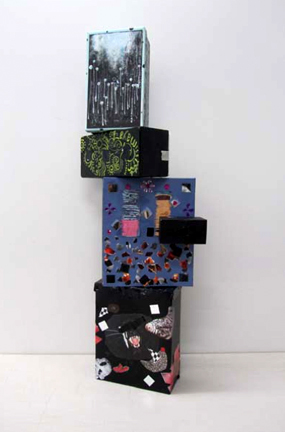
Our pinhole camera project is a collaborative installation that combines sculpture and photography in a functioning camera and art object. Each artist created and contributed a unique pinhole camera in to the installation, representing her individual voice, which with four others can create one vision. The project addresses the collective’s social and community issues as well as personal development.
The collaborative aspect of this project supports two social competencies of the MEQ (Ministère de L’Éducation du Quebec): to find a place in a group and to work with others. For these competencies, the pinhole project is most suitable for adolescent learners. The collaborative process helps learners to understand differences of opinions and to achieve consensus.
For our prototype of the project, we chose to photograph the view of Montreal from the photography department at Concordia University. We choose this location because it is common ground we share as students.
Background to the project
A pinhole camera is a lensless camera, that works by focusing light through a tiny aperture and projecting it onto the back interior surface of the inner chamber of the form. Any lightproof container can be fashioned into a pinhole camera, and while coffee cans and shoeboxes are among the most common, artists have used refrigerators, stuffed animals, hollowed out books, and just about anything else you can imagine as the basis for a camera. The image that is projected onto the back inner surface of the container can be recorded on film or on photographic paper, which becomes a negative of the world outside the camera, and a means to capture a unique vision of the world.
Pinhole cameras can be made for almost no cost and easily operated by photographers of all ages, even if it can take some tricky calculations to get a good exposure. Its unique look makes the pinhole the camera of choice for many artists (Bignell, n.d.).
Reasons for camera option
The pinhole camera as an object and a medium reflects the artistic interests and personal characteristics of the individuals in the group. The composite aspect of this project provides learners with the freedom to experiment with multiple cameras. The construction of the pinhole camera can also lead the group to explore other mediums such as collage and sculpture. These options present the opportunity for learners to explore identity and the potential for pinhole camera projects in the classroom.
Reflections on project
Lauren:
The pinhole camera is a memory maker. My pinhole camera is made with a box of chocolates from France that my boyfriend gave me. Every time I eat this chocolate, I am reminded of the love we share and the memories we created. Now that the chocolates are gone, what is left is a box of memories.
For this project, this box was transformed into a new memory maker: a pinhole camera that can capture intimate moments between us and other loved ones. I wanted to keep the outside of this pinhole camera simple, since the interior is important to me. As a result, the exterior of the camera was painted black. The embossed motif, of the word “chocolate” written in different languages, reflects my multicultural personality, and remains visible underneath the paint.
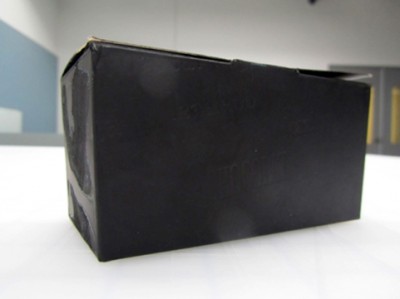
Maya:
Although I could have used a readymade box as the base for my pinhole camera, I chose to build the camera body. I wanted to have the freedom of working with my hands and use basic materials to build a my concept rather than find it through ready made materials.
Making the camera allowed me to experiment with different structures and designs. The patterns I painted onto the camera, using my favorite color green, represents my artistic nature. The pinhole camera also contains three compartments with three holes. These holes act as a metaphor for my various perspectives on life.
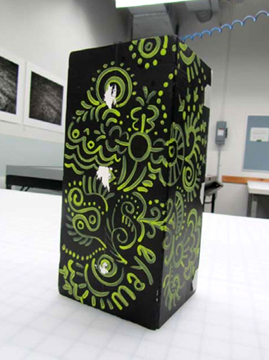
Stephanie:
My pinhole camera, like the others, was designed to represent the way in which I perceive myself. Embellished on two sides, the camera was intended to show the swift movement between thought and emotion. I decided to design the camera using both bright and dark colours as part of its concept. A philosophy class I took in Cegep inspirited this idea, where I realised the the world could be a dark place. This realization shocked me, since I often focused on the bright side of every situation. Although the vibrant side of my character remains a part of me, the balance between happiness and unhappiness has become more predominant.
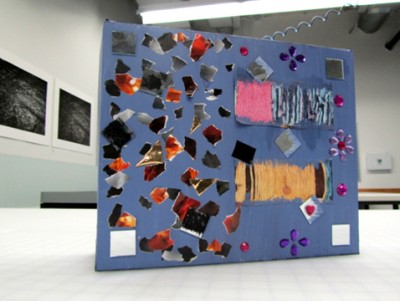
Shauna:
My pinhole camera is a reflection of my style and interests in art. The structure of the camera was initially painted black to reflect my attitude and attraction towards dark and mysterious objects. The next step was to cover the black surface using my preferred medium of exploration: collage. I chose collage because I enjoy manipulating different materials, mediums and textures in my work.
I am not afraid to take risks, which is why I posted images of animals that are known to be dangerous (such as panthers and snakes). I also added mirrors and the color red to give my pinhole camera an edge. These aesthetic decisions describe my impulsive, and less conforming styles in art. Although there are many aspects of myself illustrated on my pinhole camera, there are still many that remain a mystery.

Myriam:
The shoebox, being the most well known object used for pinhole photography, seemed to be the most obvious choice to use to create my camera. The simplicity of the medium provided a greater space for surface artwork. The art embellishing my box represents the opportunity to capture one of many visions in a photograph. To ensure precise edges of this photograph, the hole of the camera was made through a piece of metal sheet (Bignell, n.d.). The colors surrounding the hole represent the softer, feminine side of my personality, while the black reflects my style and preferences. The technical efforts I put into the creation of my pinhole expresses the hard working side of my personality.
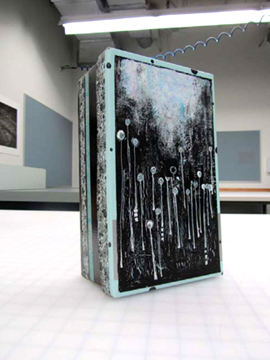
Calculations and technicalities
As part of the photography process, we used the pinhole gallery website (Bignell, n.d.) to calculate the best exposure time for each camera. Myriam, for example, took a formulaic approach to calculating the exposure times of her pinhole camera. Using the depth to hole ratio provided on the website, she estimated the relationship between the exposure, depth and hole size of her camera. Myriam’s results conclude that using ratio calculations will provide a positive outcome.
Results
Size of camera 4 inches deep
Optimal hole on website 0.5 mm
Actual hole 1 mm
Estimated f/stop 250
Estimated exposure time on website 2 minutes
Actual exposure time 3 minutes
Maya’s method for calculating exposure time on the other hand, was more experimental. Since her pinhole camera is divided into three compartments, each with its own different sized hole, the calculations for exposure times were unpredictable. At first, she decided to expose all three cameras holes for the same amount of time. However, this option posed difficulties for accurate exposure calculations. As an alternative, Maya experimented with different lengths of exposure, and found that one ‘hole’ was more successful in creating images than the other two.
For both of these examples, we compared and experimented with our results as a method to adjust exposure times for the other cameras. Some photographs were successful in the first attempt, while others required more testing. After two or three takes, everybody produced a decent photograph. Coming together as a group for a second time, we decided to make a series of new exposure tests. We concluded that the morning conditions, as opposed to the previous evening conditions, were more optimal to obtain a consistent picture.
Based on the aesthetics of our photos, we felt that our positive photographs were more successful than the negatives. As a result, our final presentation consisted of our camera sculpture grouped with the best image.
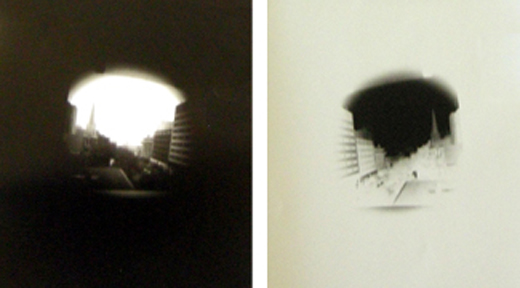
Reflections on team work
In terms of decision-making and conflict resolution, as a group we opted for consensus. We wanted each member to be fully involved in the process of the project. We were inspired by Lowe’s article on community art, in which the author states “collective decision making is fundamental to the community-building process. Most artists use a loose model of consensus that allows participants to feel ownership and to be invested in the work” (Lowe, 2001). This particular way of working made us feel involved, engaged and willing to work for the realization of the project. It also created a relaxed and fun atmosphere, around which we learned to appreciate the qualities of each other.
Connecting theory to practice
In our project, it was important that the individual artistic vision was not compromised within the group project. In fact, the activity was designed so that the individual serves the group interests, and vice versa.
As expressed in Congdon, Stewart, and White’s (2001) article “Mapping Identity for Curriculum Work,” “Our individual identities are constructed through our interaction within overlapping and intersecting communities to which we belong” (p.108). As a result, our identity as individuals and a collective influenced the art making experience.
For the duration of the project, we also built what is called a community of practice (Wenger, 2006). According to the theories of Wenger, a community of practice can be defined as groups of people who share a concern or a passion for something they do and learn how to do it better as they interact regularly. He lists three characteristics that identify a community of practice:
1- Members share interests on a specific domain, value each other’s competencies and learn from the other members.
2- Members engage in a relationship and have interactions.
3- Members share stories and resources about their practice.
In this respect, the main objective for group work is to learn by sharing an interest. Group work can be a rewarding experience for improving practice and learning collectively.
The benefits of belonging to a community of practice are numerous. Our experience in the pinhole camera project, we shared our interest in art and photography, as well as learned about ourselves as individuals and members of a community.
Conclusion
Each pinhole camera produced an acceptable image on the first attempt. Our successful tests demonstrated that basic instructions and material are all that are required to create an interesting result.
Our group dynamic was also stimulating as we were able to maintain a positive consensus throughout the project. When conflicts did arise, the group members were confident to express opinions and concerns. Aesthetically, the identity of each person was successfully expressed through the cameras. The unique and personal qualities of each pinhole added to composition and reading of the final sculpture.
References
Bignell, B. J. (n.d.). The pinhole gallery. www.pinhole.org.
Congdon, K. G., Stewart, M., & White, J. H. (2001). Mapping identity for curriculum work. In Y. Gaudelius, & P. Spears (Eds.), Contemporary issues in art education, p. 108-118. Upper Saddle River, N.J: Prentice Hall.
Lowe, S. S. (2001). The art of community transformation. Education and Urban Society, 33 (4), p. 457-471.
Wenger, E. (2006). Communities of practice: A brief introduction. www.ewenger.com.